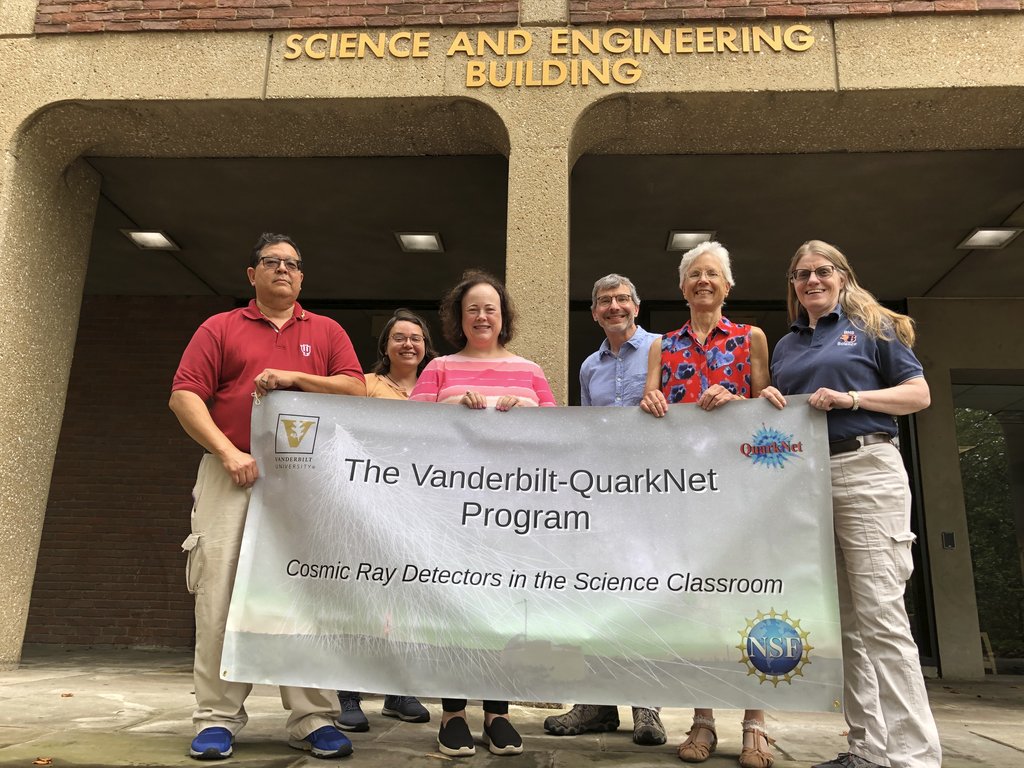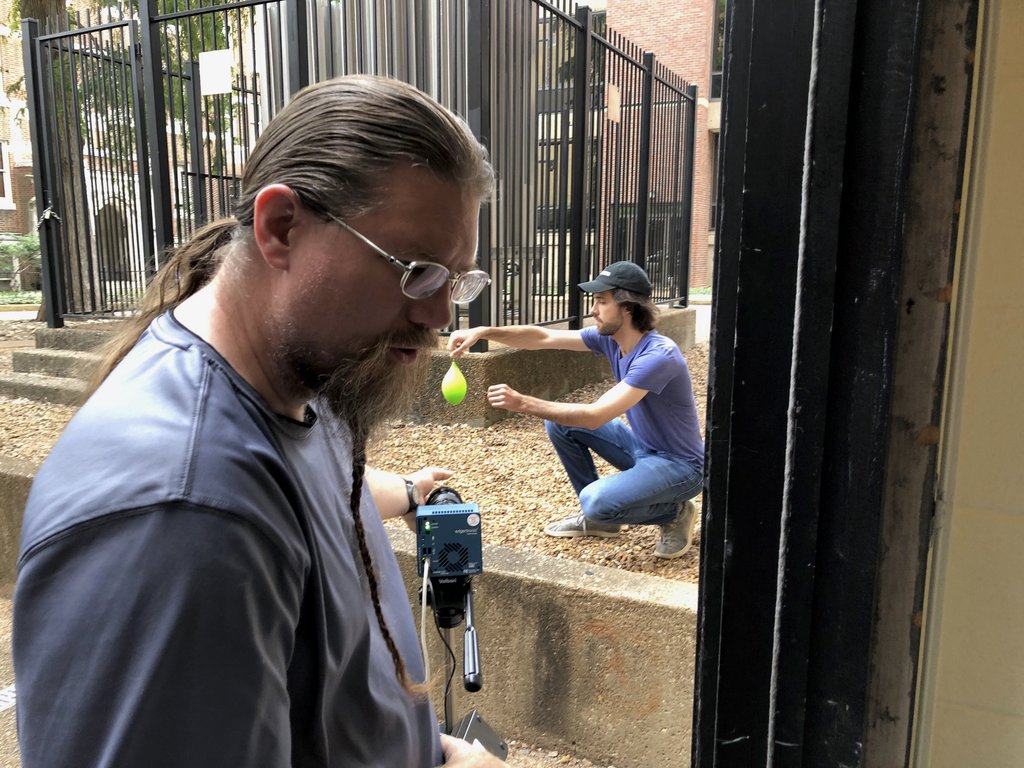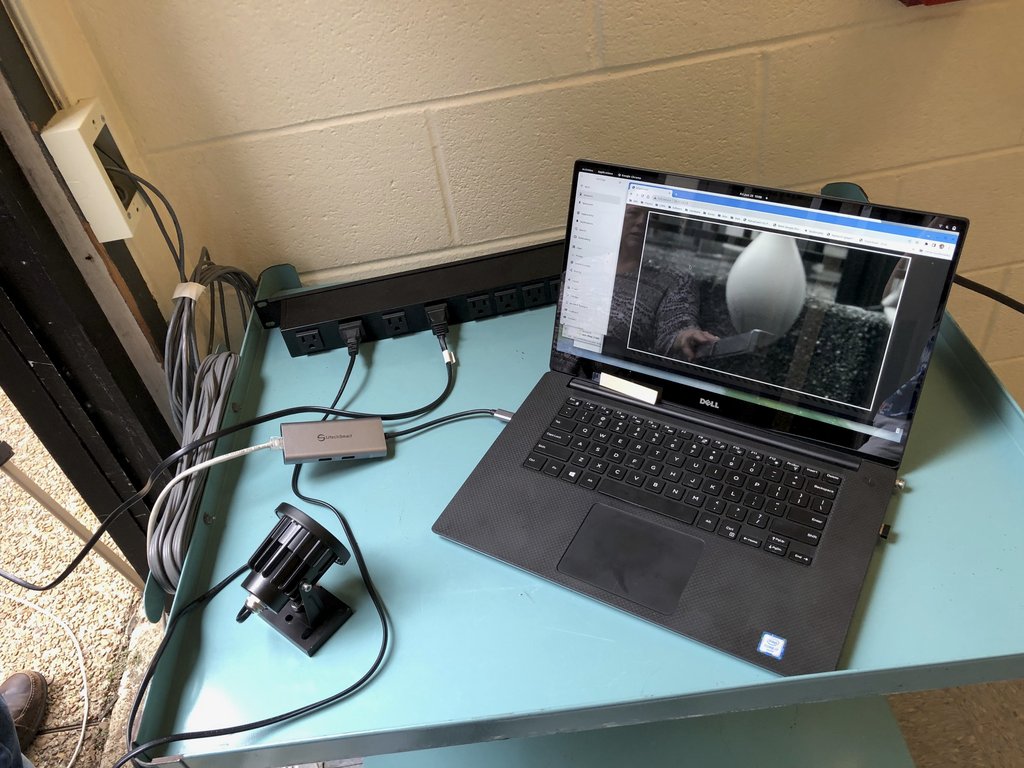Annual Report 2023 - Vanderbilt University

Vanderbilt University QuarkNet 2023
Personnel
The Vanderbilt University QuarkNet group is mentored by William (Bill) Gabella. I advise the teachers and students on the use of the Cosmic Ray Muon Detectors (CRMDs), maintain them, and help with either setup of our loaned out CRMDs or with those that are permanently at a school. I also plan and host the summer workshop for the teachers. For several years now, I could count on the help of several volunteers: Diana Gigante a retired physics teach and long-time QuarkNet teacher, Nick Spurlock a graduate student in our Biomedical Engineering Department, and Dr. Sara Frederick a post-doctoral research in astrophyiscs from our Department of Physics and Astronomy.
Cosmic Ray Muon Detectors
The Vanderbilt QuarkNet has several Center CRMDs: S/N 6181, 6165, 6891, 6851, 6795 are conventional cosmic ray muon detectors, and S/N 6925 is an "unconventional" one---it has smaller scintillator paddles. S/N 6925 no longer has a dedicated DAQ card; it is most useful for looking at attenuation of the muon flux with materials, like water, or bricks, stacked between pairs of scintillators. These are routinely loaned to our high school teachers for their club and classroom work; this last year there has not been a lot of activity for the loaners. The laptops running the detectors are old, so we are seeking newer ones. We also have several CRMDs that are permanently in the schools:
S/N 6850 in Nashville, TN, with James Anderson;
S/N 6892 in Murfreesboro, TN, with Kim Baumann and Gayle Dawson.
The two detectors 6795 and 6851 work very well, and show very steady singles rates. With several new teachers showing interest, these are likely to be given to schools in the area. On a few channels in the other detectors, I do see long-term steady singles rates, for weeks and months, and then sudden changes which may also be stable for weeks. I assume the PMT plus voltage multiplier might be having problems. Will pursue diagnostics and repairs.
It is my habit to run the detectors, usually at least three of them, all the time. I do upload the files but they are rarely blessed data sets, as the runs are long enough that step changes in the singles rates are quite common. Will try to resolve this problem.
We are using the Java program Equip for managing the CRMDs running on the Fedora Linux laptops that we have. This works but there are several aspects of it that would be nice to have working and maintained: The GPS mapping and location no longer works. Perhaps an enhancement to output the scintillator/CRMDS geometry in a file format that can be uploaded to eLab. Also a facility to output a spreadsheet of the rise and fall times of complete pulses, like the older LabVIEW program capability, would be helpful. We use a custom Fortran program for this function currently. We understand that eLab can also create this file. I strongly encourage the Python development for controlling the CRMDs which I understand is ongoing. That code base would be accessible to many high school students, and college students could be skilled enough in programming to contribute to the project.
Summer Workshop 19-23 June 2023
The main activity of the Vanderbilt QuarkNet Group is hosting the five-day workshop for current group members and interested science teachers. This year the theme was "YouTube style videos," put generically. It was to learn some basics about analyzing videos for physics content, creating educational physics animations, and editing and creating full videos for physics and science and math education. Ken Cecire joined us online to greet the teachers during the workshop.
Monday is our day for introductions and talks from scientists---news in a field, or other scientific enrichment talks. We also heard from faculty and graduates students on their research areas. Recently minted PhD Dale Julson gave a talk on high-energy physics in general and included his research at the CERN LHC and CMS Detector on searching for dark matter, especially if it was a result of SuperSymmetry. Bill Gabella talked about gravitational waves and the recent re-start of the LIGO data taking. Graduate student Krystal Ruiz-Rocha talked about her research into binary blacks and their distribution inferred from cosmological N-body simulations and the application to the future space-based gravitational wave detector LISA. We heard about ChatGPT and similar AI assistants from Dr. Charreau Bell the senior data scientist at the Vanderbilt University's Data Science Institute. Useful after all the hesitation in high schools to use ChatGPT-like tools, to hear about them and how they can be usefully used. Sara Frederick, a post-doctoral researcher in our active galactic nuclei group, gave a discussion of the observational research she does looking at the spectroscopy of supermassive black holes at the centers of (likely all) galaxies. The talks seemed well-received and led to good discussions.
Tuesday we introduced the video theme of the week with three main aspects: Video Analysis with Tracker, Animation mostly with XXX, and Video editing as it turned out with Clipchamp. We shot some video and worked analyzing it with Tracker code. We started with the tutorial that uses the rolling ball that falls off the table. Tracker lets you record the X and Y positions and uses the frame information for the time. We analyzed dropping ball video that we shot, as well as others. We also analyzed the YouTube video of the stars and hot gas clouds moving around the Milky Way's supermassive black hole Sagittarius A-star to get the orbit and estimate the mass of the black hole. Tracker is a great tool, but does have a learning curve that you need to work though.
Wednesday and Thursday included more Tracker efforts, but added to it creating animation with VPython but using the tool XXX and by Thursday trying to put together some Tracker analysis with music, and titles, and narration, into a final video product. James Anderson on of our teachers taught us a great tool for this called Clipchamp, that has some stock music and graphics and all in the public domain. We also brought out a high speed camera capable of 2400 frames per second and imaged water drops falling into a petri disk of water. Those looked great. Attempts to image a popping balloon showed us that the balloon remnants move very fast. Less satisfying that other high speed videos. We also did some with our smart phones, many of which are capable of 240 frames per second---good for many fast action science.
Using the animation tool(s), Bill and Hannah attempted to model the muons as rays hitting a two scintillator telescope configuration. Hopeful that we might estimate the sky coverage and thus the coincidence rate. That level of expertise was not exhibited, but it was a good exercise nonetheless.
Friday was a day to discuss the Cosmic Ray Muon Detectors and eLabs. It was also a typical wrap-up day, we discussed implementation plans and what has worked for the veteran QuarkNet teachers. We finished any outstanding projects from earlier in the week. We also did the QuarkNet survey any other administration.

June 2023 Workshop
|

|

|

|
Outlook
Several of our veteran teachers have retired, and more will retire in the next years. So the need for new teachers to keep the group useful for the teachers, some sort of critical mass, is important. I will try to increase the presence of QuarkNet at outreach activities, as I am able. I found that my usual email announcements about the one week workshop found some new folks. Besides emailing it to people and professors I know, I routinely email it to the head of science/STEM education in the nearby school districts. Those heads of science education then email it to their STEM teacher list. Still I found it was a few teachers' word-of-mouth that really helped bring in new teachers, both to the workshop and to query me about the program. All-in-all, this is the challenge for our Vanderbilt-QuarkNet Group, to increase the number of active teachers and to bring in new teachers.
Links of Interest
(New-ish) GitHub page for 2023 workshop https://github.com/gabella/VandyQuarkNet/tree/master/quarknet2023
Local web page, out-of-date http://www.hep.vanderbilt.edu/~gabellwe/qnweb
Facebook group page https://www.facebook.com/groups/682323215235912/
Vanderbilt QuarkNet Page (drupal, i.e. here) /group/vanderbilt-university-quarknet-center
Vanderbil Data Science Institute https://www.vanderbilt.edu/datascience/
[Edited by Bill Gabella 20231016]